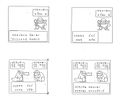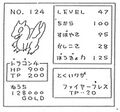Capsule Monsters
Capsule Monsters (Japanese: カプセルモンスター Capsule Monsters) was Satoshi Tajiri's early design concept of Pokémon, first proposed to Nintendo as early as 1990. According to the book Pikachu's Global Adventure, this early concept traces all the way back to Tajiri's childhood years, during which he had enjoyed bug collecting.
The name "Capsule Monsters" is inspired by Japanese gashapon machines.[1] Apparently, Tajiri had trouble trademarking the name "Capsule Monsters" so he changed it first to カプモン CapuMon and then later "Pocket Monsters".
Various Pokémon are known or believed to have originated from this early concept work, including Lapras, Gastly, and Slowbro, though many of the concept sketches included generic looking creatures such as simple dragon and apelike figures that may have eventually been developed into many of the existing Pokémon.
Presumably, monsters were not caught through combat, as in the final Pokémon mechanics. Instead, the Trainer had a Charisma stat that had to be raised to entice wild monsters to join them.[2] The Trainer may restore their monster's health by staying at the hotel, which provided healing devices in rooms, similar to a Pokémon Center.
In addition, some concept art shows Trainers buying monsters in a pet-store like setting, probably a similar concept to purchasing Pokémon at the Game Corner or from the Magikarp salesman. The original pitch also did not include the paired games with the Version-exclusive concept; instead, trading would be encouraged by "Mirage Monsters", creatures with a very low encounter rate. One Mirage Monster mentioned was a Green Dragon, which would be encountered in a dungeon. It is said that it would have taken up to 2 hours to find and catch.
Artwork
An early design of the map of Kanto, also showing an alternate logo
Mock-ups featuring a Beast Tamer, as well as Godzillante & Gorillaimo
A mock-up featuring Dragon4
Grave of the Mythical Beasts, possibly a precursor to Pokémon Tower
A hotel, possibly a precursor to the Celadon Hotel or the Pokémon Center
A hotel bedroom, featuring the female player character
A shop concept
The male player character and a Gyaōn exploring a cave
Heading for the harbor atop an early Lapras
Trivia
- Capsule Monsters may have been inspired by characters of the same name from Ultraman franchise and Gamera in the 1995 short film Cosplay Warrior Cutie Knight.[3]
- "Capsule Monsters" was the name of a game that appeared in the early Yu-Gi-Oh! manga, which was later adapted into a short spin-off anime series and board game.















